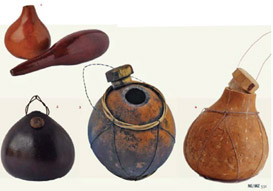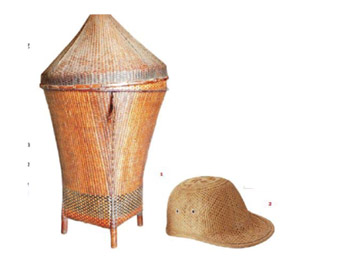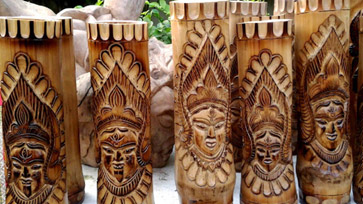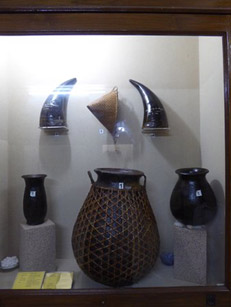
Puan is a traditional handwoven fabric. It is traditionally made of cotton yarn, spun by women on loin looms called puanbu. Workshops are found in Zuangtui, where weavers live and work. Puan are produced mainly in Aizawl and the Serchhip district of Thenzawl. Culturally significant patterns like ginger flowers, roses and stars are usually used on puan. For example, the hmarm is the oldest patterned textile of the Lusei tribe. Disul and hruih are lines which remain standard across designs. Different types of puan serve different purposes. For example, pawndum is used as a shroud to cover the dead and twalhohpuan is worn by courageous warriors to display their bravery.
References

Gourds, or um, are cultivated in Mizoram for food and craft. They are usually made into containers for storage, but are being rapidly replaced by glass and plastic. Larger gourds are used to make water containers called tuithawl and smaller ones are made animal fat containers called sa-um bur. The biggest gourds, which store 25 litres of water, are called chhura umpui. Gourds are encased with thin strips of cane, which are braided around them and then smoked above a fireplace. They are crafted and shaped by knives called dao. Bowls and musical instruments like the tingtang – a one-stringed instrument with bamboo – fitted in the gourd are also made.
References

Many Mizo tribes are Christians with a rich tradition of bamboo (mitperh) and cane (phulrua) crafts. Over 50% of Mizoram is covered with bamboo. Because of this high availability, bamboo is a big part of craft and culture, and is used to build homes. It is the main element of the traditional dance, cheraw. Bamboo baskets are used for storage.They are usually weaved by men. The Lushai tribe is involved in their production. The paikwang is used for heavier loads like firewood, while the emsin is for lighter weights. The paiem is used to carry produce from fields and the thul has four legs to raise it above the ground. The baskets are strengthened with cane, because of its hard and durable nature. It is also smoked to give colour. Bamboo is used to make the traditional cap - khumbeu. Cane and bamboo are used to make furniture like the traditional mizo stool, toys like the bamboo pop-gun and smoking pipes like vaibul for men and tuibur for women.
References

Wood carvings are made on bamboo, mango and sheesham wood. This art form is used for religious and ceremonial purposes and is usually found on small shrines, marriage stools, carved fans for the deity and small ceremonial containers. Carvings are usually of human figures. Front doors of houses are carved with motifs like the hamsa (mythical swan), padma (lotus) and flowers. Carved wooden toys, dolls and elephants are also made. These products are manufactured mainly in the Hnam district. The Baktawng district is so famous for carpentry that it is called the 'Carpentry Hamlet of Mizoram'. 70% of the households there rely on carpentry as their occupation.
References

Terracotta is used to make pots for storage. Cherzing and Khawn Zubel are used to store zu - a local liquor. These pots are rarely found today. Chaw Chhum Bel is a container used for cooking. The clay for it is gathered from the lower jungle by women, which has darker clay than the upper lands. These pots are shaped by hand, without using a pottery wheel. The Vawkchaw Bel is a larger pot used to cook food for pigs. A clay lid called the Khuhhriang was used to cover the pot while cooking. However, the practice of making this declined, with its replacement by wooden lids.
References